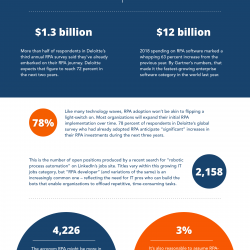Claritus Clarity | Innovation | Technology SRRA 11 Interesting Stats Of Robotic Process Automation (RPA) RPA software ranked as the fastest-growing enterprise software category in 2018, and the spending arrow continues to point up so far in 2019. Analysts and other sources indicate similarly exuberant views of RPA adoption, as companies seek new efficiencies to enable their digital transformation and other initiatives. To give you some context on RPA, we’ve gathered some of the most compelling stats. Robotic Process Automation (RPA) statistics to see 53% 63% More than half of respondents in Deloitte’s third annual RPA survey said they’ve already embarked on their RPA journey. Deloitte expects that figure to reach 72 percent in 2018 spending on RPA software marked a whopping 63 percent increase from the previous year. By Gartner’s numbers, that made it the fastest-growing enterprise software category in the world last year. the next two years. $1.3 billion $12 billion More than half of respondents in Deloitte’s third annual RPA survey said they’ve already embarked on their RPA journey. Deloitte expects that figure to reach 72 percent in 2018 spending on RPA software marked a whopping 63 percent increase from the previous year. By Gartner’s numbers, that made it the fastest-growing enterprise software category in the world last year. the next two years. Like many technology waves, RPA adoption won’t be akin to flipping a light-switch on. Most organizations will expand their initial RPA implementation over time. 78 percent of respondents in Deloitte’s global survey who had already adopted RPA anticipate “significant” increases in their RPA investments during the next three 78% years. This is the number of open positions produced by a recent search for “robotic process automation” on Linkedln’s jobs site. Titles vary within this growing IT jobs category, but “RPA developer” (and variations of the same) is an increasingly common one reflecting the need for IT pros who can build the bots that enable organizations to offload repetitive, time-consuming tasks. 2,158 4,226 3% The acronym RPA might be more in It’s also reasonable to assume RPA- related hiring will grow. Deloitte’s RPA survey notes that companies’ enthusiasm for the technology is vogue tha for: Searching “RPA” on LinkedIn produced nearly double the number of job openings. Oddly enough, though, this flips on the jobs site Indeed, with the full phrase the full phrase it stands tempered by a current reality: Just 3 percent of respondents said they’ve scaled their digital workforce – meaning the bots that perform work as digital employees, much like human employees to this point. generating 5,037 results while the acronym returns 2,792 positions. The percentage of employee respondents, in a recent survey conducted by RPA software vendor NICE, which listed compliance improvements as the leading benefit of RPA adoption. That gave it the largest slice of the pie, topping improved productivity/performance (27 percent) and other 38% benefits. Compliance improvements also led the list of RPA benefits in Deloitte’s survey, with a whopping 92 percent of respondents saying RPA met or exceeded their expectations on this front. That was followed by improved quality/accuracy (90 percent), improved productivity (86 percent), and cost reduction (59 percent) as areas where RPA met or exceeded expectations. There is some obvious overlap between these benefits; improved quality and accuracy in your processes almost inevitably will be a boon for compliance, for example. 92% RPA opportunities exist in many business functions, but some departments have developed a particularly keen interest in the technology. More than 70 percent of finance organizations have piloted or are actively using RPA, according to Gartner. 70% CONTACT: info@claritusconsulting.com Claritus Clarity | Innovation | Technologyread more
11 Interesting Stats Of Robotic Process Automation (RPA)


